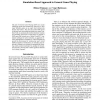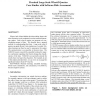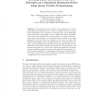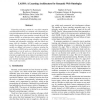850 search results - page 22 / 170 » Using Machine Learning to Guide Architecture Simulation |
BMCBI
2008
13 years 8 months ago
2008
Background: We present a novel method of protein fold decoy discrimination using machine learning, more specifically using neural networks. Here, decoy discrimination is represent...
AAAI
2008
13 years 10 months ago
2008
The aim of General Game Playing (GGP) is to create intelligent agents that automatically learn how to play many different games at an expert level without any human intervention. ...
KBSE
2000
IEEE
14 years 9 days ago
2000
IEEE
When a lack of data inhibits decision making, large scale what-if queries can be conducted over the uncertain parameter ranges. Such what-if queries can generate an overwhelming a...
GECCO
2003
Springer
14 years 1 months ago
2003
Springer
We describe the first instance of an approach for control programming of humanoid robots, based on evolution as the main adaptation mechanism. In an attempt to overcome some of th...
ICMLA
2004
13 years 9 months ago
2004
Expressing web page content in a way that computers can understand is the key to a semantic web. Generating ontological information from the web automatically using machine learni...




